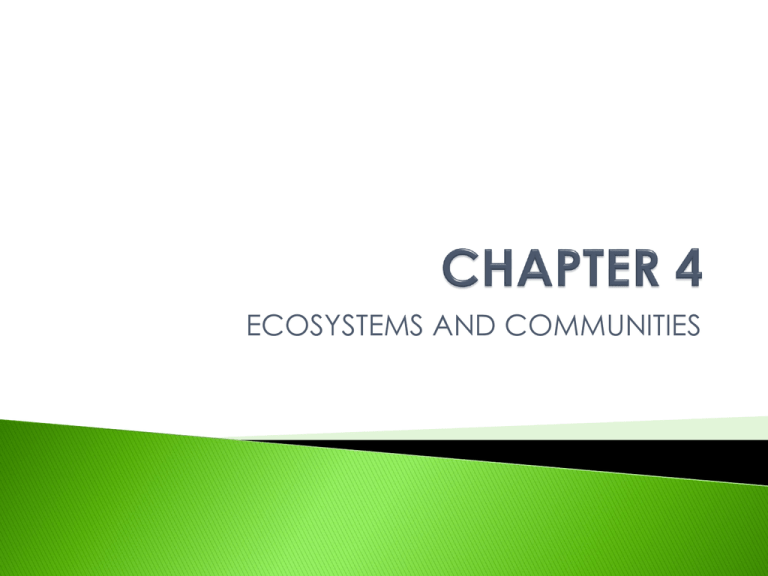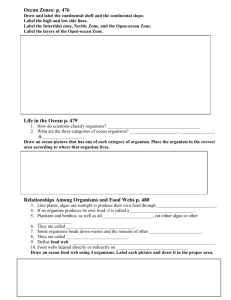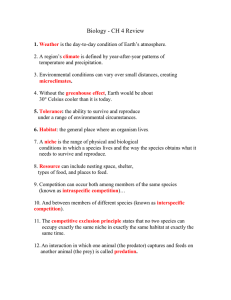chapter 4 - My Teacher Pages
advertisement

ECOSYSTEMS AND COMMUNITIES Weather includes the daily conditions of Earth’s atmosphere at a particular time and place Weather includes temperature and precipitation Climate involves the average, year after year conditions of temperature and precipitation in a particular region Climate is caused by the trapping of heat by the atmosphere, latitude, the transport of heat by wind and ocean currents, and the amount of precipitation that results 1. 2. solar energy presence of certain gases in the atmosphere The natural insulating blanket of the biosphere=atmosphere Carbon dioxide, methane, water vapor, and a few other atmospheric gases trap heat energy and maintain Earth’s temperature range 1. 2. 3. 4. Greenhouse gases allow solar energy to penetrate the atmosphere in the form of sunlight Most sunlight hits the surface of our planet and is converted into heat energy and radiated back into the atmosphere Heat energy is not allowed to pass out of the atmosphere as readily as light energy enters it The greenhouse gases trap heat inside the earth’s atmosphere Earth is a sphere tilted on its axis, so solar radiation strikes different parts of Earth’s surface at an angle which varies throughout the year 0 degrees latitude=equator=sun is directly overhead at noon all yearmore heat 90 degrees latitude=north and south poles=sun is lower in the sky for months at a timeless heat The difference in heat distribution with latitude has important effects on Earth’s climate zones 1. 2. 3. Polar zones: cold areas where sun’s rays strike Earth at low angles. Located in areas at the North and South poles, between 66.5 degrees and 90 degrees N and S latitude Temperate zones: between the polar zones and tropics; climate ranges from hot to cold, depending on the season Tropical zone (Tropics): near the equator between 23.5 degrees N and S latitude. The tropics receive direct or nearly direct sunlight all year, making the climate almost always warm Unequal heating of Earth’s surface drives winds and ocean currents, which transport heat throughout the biosphere Winds form because the warm air rises and cool air sinks. Air at the equator rises at the same time, cool air from the poles sinks. The upward movement of warm air and downward movement of cool air creates air currents (wind) that move heat through the atmosphere from regions of sinking air to regions of rising air Prevailing winds bring warm or cold air to a region Similar patterns of heating and cooling occur in oceans Ocean currents transport heat energy within the biosphere; the surface ocean currents warm or cool the air above them, which affects weather and climate of the land masses Mountains cause moist air masses to rise, clouds form and precipitation begins on the mountains. Once the air mass reaches the far side of the mountain, it has lost moisture=this is called a rain shadow. Read chapter 4 section 1 in your book and complete chapter 4 section 1 guided reading worksheets!!!! Biotic factors are living things within an ecosystem. Examples: trees, birds, plants, bacteria Abiotic factors are physical, non-living factors that affect an ecosystem Examples: temperature, precipitation ***Together, biotic and abiotic factors determine the survival and growth of an organism and the productivity of the ecosystem in which the organism lives. Habitats are areas where organisms live A niche is the full range of physical and biological conditions in which an organism lives and the way in which the organism uses those conditions Example: the type of food the organism eats, how it obtains this food, and which other species use the organism as food Competition, predation, and various forms of symbiosis can powerfully affect an ecosystem Competition occurs when organisms of the same or different species attempts to use an ecological resource in the same place at the same time Resources are necessities for life. Examples include water, nutrients, light, food and space Competitive exclusion principle: no two species can occupy the same niche in the same habitat at the same time Direct competition in nature results in a winner and a loser, where the losing organism fails to survive Predation: when one organism captures and feeds on another organism Predator: organism that does the killing Prey: organism that becomes the food Symbiosis: any relationship in which two species live closely together 1. 2. Mutualism: both species benefit from the relationship. Example: flowers provide insects with food and insects help flowers reproduce by pollinating them Commensalism: one member in the relationship benefits and the other isn’t affected. Example: barnacles attach themselves to whales. The barnacles benefit from the constant movement of water as it carries food particles to them. The whales are not helped nor harmed. 3. Parasitism: one organism lives on or inside another organism and harms it. Example: tapeworms are parasites that live in the intestines of mammals (host). The parasite obtains all or part of its nutritional needs; they weaken the host but rarely kill them Ecosystems and communities are always changing in response to natural and human disturbances. As an ecosystem changes, older inhabitants gradually die out and new organisms move in, causing further changes in the community. This process is called ecological succession. Primary succession: succession on land surfaces where no soil exists. Example: occurs on surfaces formed from volcanic eruptions that have built new islands 1. No soil: just ashes and rock 2. Pioneer species: first species to populate the area (ex. Lichens, fungi and algae on rock) 3. When pioneer species (lichens) grow, the rock breaks apart 4. Lichens die and add organic material to help form soil Secondary succession occurs when land cleared and plowed for farming is abandoned. Secondary succession also occurs after wildfires burn woodlands Climax species: mature, stable species that don’t undergo further succession 1. 2. 3. A whale dies and sinks to the barren ocean floor; the carcass attracts scavengers and decomposers that feast on decaying meat (ex. Sharks) Within a year, most tissue has been eaten and the carcass supports a smaller number of fish, crabs, snails; the decomposition of the whale enriches sediment with nutrients where marine worms begin to live When the skeleton remains, heterotrophic bacteria decompose the oils inside the whale bones which release compounds that serve as energy sources for chemosynthetic autotrophs (ex. Mussels, worms, crabs, clams) ***re-read section 4-2 pages 90-97 in your book and complete the guided reading worksheets*** A biome is a physical environment that contains characteristic assembly of plants and animals The major biomes include: 1. Tropical rain forest 2. Tropical dry forest 3. Tropical savanna 4. Desert 5. Temperate grassland 6. Temperate woodlands/shrublands 7. Temperate deciduous forest 8. Northwestern coniferous forest 9. Boreal forest 10. Arctic tundra The two main factors that determine climate are temperature and precipitation Both temp. and precipitation can be summarized on a graph called a climate diagram A microclimate is a climate within a small area that differs significantly from the climate around it (example: San Francisco=certain streets within the city are blanketed with a thick fog, while the sun shines a few blocks away) Each biome is defined by a unique set of abiotic factors, particularly climate, and has a characteristic ecological community. Transitional areas between biomes =one biome’s plants and animals gradually become less frequent, while the organism characteristics of the adjacent biome becomes more frequent Mountain ranges and polar ice caps do not fall into the major biome categories Mountain ranges are found on all continents. Abiotic and biotic conditions vary with elevation As you move up from base of mountain to summit, temperature becomes colder and precipitation increases. Types of plants and animals change as a result. Polar ice caps involve the polar regions that border the arctic tundra and are cold yearround ***READ PAGES 98-105 AND COMPLETE 4-3 GUIDED READING WORKSHEETS*** 3/4 of earth’s surface is covered in water Water communities include oceans, streams, lakes, and marshes. Water communities are controlled by biotic and a biotic factors including light, nutrient availability and oxygen. Aquatic ecosystems are determined primarily by the depth, flow, temperature and chemistry of the overlying water. 1. Aquatic ecosystems are grouped according to the abiotic factors that affect them 2. Land biomes are grouped geographically 1. 2. 3. Depth of water: distance from the shore determines the amount of light organisms receive Water chemistry: amount of dissolved chemicals (salts, nutrients, oxygen) on which life depends Latitude: aquatic ecosystems in polar, temperate, and tropical oceans all have distinctive characteristics Two main types: flowing water and standing water 1. Flowing water ecosystems: a) rivers, streams, creeks, brooks b) Organisms are well adapted to the rate of flow c) Originate in mountains or hills from underground sources d) Rapid water has a higher amount of distilled water but little plant life e) Moving downhill, sediments build up and plants establish themselves f) Slow moving water through flat areas where turtles and river otters make their homes 2. Standing water ecosystems a) Lakes and ponds b) Water circulates within them and usually flows in and out c) Circulation distributes heat, oxygen, and nutrients d) Plankton live here: tiny free floating or weakly swimming organisms that live in freshwater and saltwater environments e) Phytoplankton: single celled algae supported by nutrients in water and form the base of aquatic food webs f) Zooplankton: planktonic animals that feed on phytoplankton A wetland is an ecosystem in which water either covers the soil or is present at or near the surface of the soil for at least part of the year A wetland is usually a mixture of salt and freshwater It is a breeding ground for insects, fish, amphibians, and migratory birds 1. 2. 3. Bogs: usually form in depressions called “kettle holes” left by icy sheets that melted thousands of years ago. Sphagnum moss grows here because water is acidic. Marshes: shallow wetlands along rivers. They may be underwater for all or part of a year. Contains cattails and tall, grasslike plants Swamps: slowly moving water that looks like a flooded forest. Contains trees and shrubs. Wetlands formed where rivers meet the sea Mixture of freshwater and saltwater Affected by the rise and fall of ocean tides Most are shallow, so sunlight reaches the bottom to begin photosynthesis Primary producers are plants, algae and bacteria Most primary production is NOT consumed by herbivores. Instead, it enters the food web as detritus=tiny pieces of organic material that provide food for organisms at the base of the estuary’s food web (ex. Clams, worms, sponges) Salt marshes: temperate zone estuaries dominated by salt tolerant grasses above the low tide line and sea grasses under water Mangrove swamps: coastal wetlands that are widespread across tropical regions. Dominant plants are salt tolerant trees and sea grasses. It is a valuable nursery for fish and shellfish. The largest in the United States is the Florida Everglades National Park 1. 2. Photic zone: well lit upper layer where photosynthesis takes place. Depth of 200 meters; where algae and other producers grow Aphotic zone: permanently dark layer just beneath the photic zone; chemosynthetic autotrophs can survive here Ocean zones are based on the depth and distance from the shore. They are the intertidal zone, the coastal ocean, and the open ocean. Each zone supports distinct ecological communities Regular and extreme changes in surroundings One or two times, the zone is submerged in seawater. The rest of the time, it is exposed to air, sun and temperature changes Battered by waves and strong currents Exists in temperate regions where exposed rocks line the shore Barnacles and seaweed permanently attach themselves to rocks Snails and sea urchins cling to rocks by their feet Zonation=prominent, horizontal banding of organisms that live in a particular habitat. In the rocky intertidal zone, each band can be distinguished by differences in color or shape of the major organisms Extends from the low-tide mark to the outer edge of the continental shelf. It is the relatively shallow border that surrounds the continents. Rich in plankton and other organisms Example: kelp forests=giant brown algae that can grow as much as 50 cm a day. It is found in cold, temperate seas around the world. They support a food web of snails, sea otters, fish, seals, and whales Named for the coral animals whose hard, calcium carbonate skeletons make up their primary structure Most diverse and productive environments on earth Coral animals=use tentacles to capture and eat microscopic creatures; they cannot grow in cold water or water low in salt. They live in symbiosis with algae. Almost all growth in a coral reef occurs within 40m of the surface The oceanic zone begins at the edge of the continental shelf and extends outward it is the largest marine zone covering more than 90 % of surface area of the world’s oceans Organisms are exposed to high pressure, frigid temperatures, and total darkness Fish of all shapes and sizes dominate the open ocean (swordfish, octopus) Dolphins and whales could live here, but must stay near the surface to breathe The ocean floor Benthos=organisms that live attached to or near the bottom (sea stars, sea anemones, marine worms) The zone extends horizontally along the ocean floor from the coastal ocean through the open ocean Benthic ecosystems depend on food from organisms that grow in the photic zone (producers) They feed on pieces of dead organic material (detritus) that drift downward from the surface of the water Chemosynthetic bacteria= support life without light and photosynthesis They live near deep-sea vents where superheated water boils out of cracks on the ocean floor *Read pages 106-112 in your textbook. Complete guided reading worksheets section 4-4. **Prepare for a test!!!!








